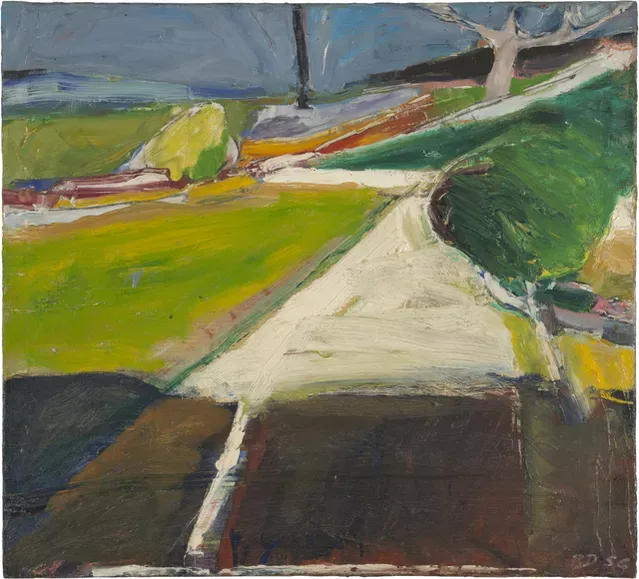My sister Chris has introduced me to works by the artist Richard Diebenkorn.
RICHARD DIEBENKORN
Richard Diebenkorn (April 22, 1922 – March 30, 1993)
I had never heard of this artist until a couple of days ago when Chris sent me an email concerning some new works which she has discovered since she took up painting watercolours two years ago.
Chris's new-found love of painting has led her to enquire into the lives and works of a whole new range of painters she had never heard of previously. So now I get to learn about them from her.
Chris's reflections are inserted between each these paintings by Richard Diebenkorn.
I'm sure Chris would like to hear your responses to them too.
DRIVEWAY 1956
Oil on canvas.
The beauty of something so ordinary.
Colours and shapes stand out to make me feel like a coming home, or arrival.
I like the shade I’m invited into.
I like how he’s painted part of it, then gone over it with other colours that let the underneath layer show through.
COFFEE
1959
She seems so intriguing. So debonair and smooth.
And yet she is made of such rough brushstrokes.
I like how much she is enjoying that cup of coffee.
Berkeley 12
The Phillips Collection
Oil on canvas
I love how this flat landscape seems to be just that.
Squares and ragged rectangles.
Aerial.
Boxed shapes of different sizes and colours.
But I sort of fall into it.
Then I want to know why they are separated sometimes by such whimsical, fine black lines.
Look at the colour of that water. So inviting. But it is so flat, and how has he invited me into this scene that seems to have so much depth?
I love the softness of the aqua-bluey-green against the ochre and rawness of the background. Into Black. What is that?
Richard Diebenkorn, Still Life with Orange Peel, 1955;
San Francisco Museum of Modern Art, bequest of Barbara E. Foster;
© The Richard Diebenkorn Foundation
Those colours are all seemingly at odds with each other. But I love them. They are like some kind of interesting mix of ice creams that make me want to taste them. I like how the perspective is not even suggested. It just is what it is for you to do what you want with it. From above? But then there is the detail of the reflection on the bottle!
After writing about these paintings I did some more research and stumbled up this:
Notes to myself: Diebenkorn’s 10 rules for painting
By Louise Cohen and Harriet Baker, Published 13 March 2015
Sometime in his later career, Diebenkorn wrote down ten points of
artistic intention.
Sharing them here, we also begin a new series of notes, asking artists
to share their own creative wisdom.
For Richard Diebenkorn, each painting was a search for what he called “rightness.” Revered as one of the great post-war masters in his native United States, Diebenkorn moved from abstraction to figuration and back again, often disregarding the popular styles and trends happening around him, in order to solve complex, self-imposed compositional problems in his paintings.
Probably sometime during his later, second phase of abstraction, Diebenkorn made the following list for himself – titled Notes to myself on beginning a painting. As the art historian John Elderfield said when he first published them in 1997, these “studio notes”, as Diebenkorn called them, are not so much rules as statements of “artistic intention.” Presumably, they were reminders to himself to observe in his studio, though we know that Diebenkorn did also share them with authors in his lifetime.
While of course today these notes help us further understand and appreciate Diebenkorn’s work, they may also be useful for today’s artists. Whether they are directly relevant to another practise or not, a master’s own notes on approaching that enduring challenge – how to start making art – may well prove a valuable source of inspiration.
"Notes to myself on beginning a painting"
- by Richard Diebenkorn
1. Attempt what is not certain. Certainty may or may not come later. It may then be a valuable delusion.
2. The pretty, initial position which falls short of completeness is not to be valued – except as a stimulus for further moves.
3. DO search.
4. Use and respond to the initial fresh qualities but consider them absolutely expendable.
5. Don’t “discover” a subject – of any kind.
6. Somehow don’t be bored but if you must, use it in action. Use its destructive potential.
7. Mistakes can’t be erased but they move you from your present position.
8. Keep thinking about Pollyanna.
9. Tolerate chaos.
10. Be careful only in a perverse way.







3 years ago an artist friend mentioned him, so I searched via wikiart and ended up discovering this little gem of a film https://vimeo.com/363649438?embedded=true&source=vimeo_logo&owner=81436028
ReplyDeleteThanks for that Alexandra.
ReplyDelete